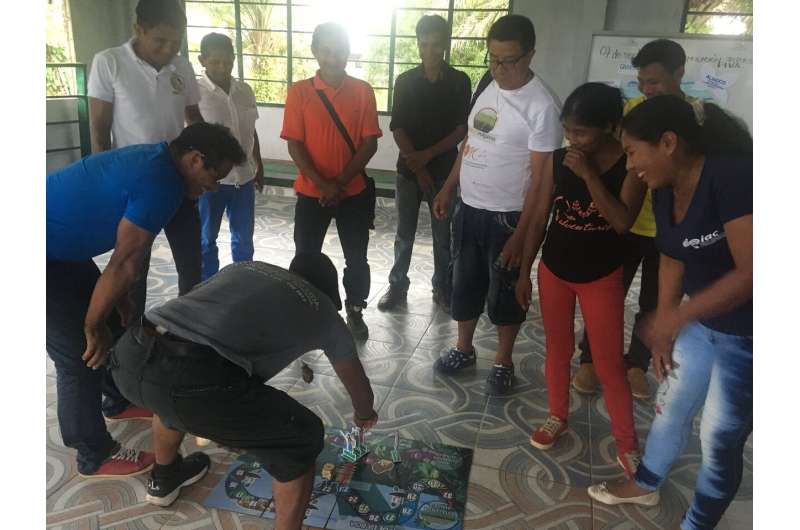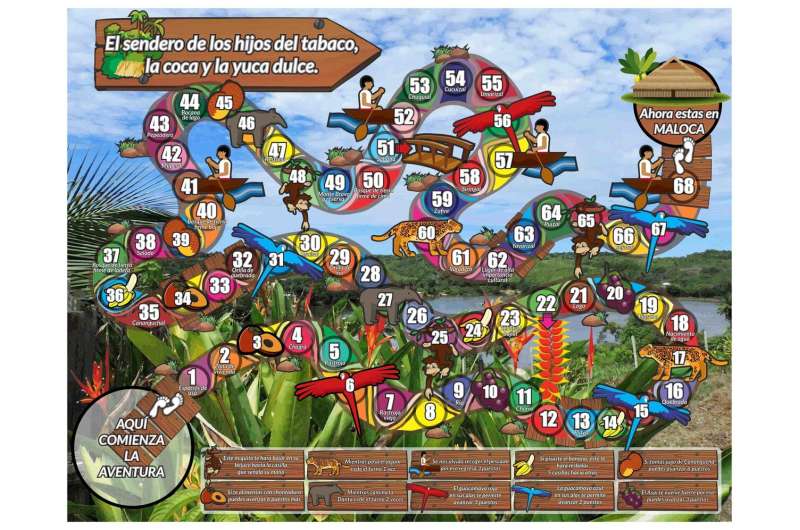Community members playing "El sendero de los hijos del tabaco, la coca y la yuca dulce." Credit: WWF-Colombia
In the Colombian Amazon, we find an indigenous organization that manages the protection of around two million hectares of rainforest. As we covered in a previous article, this organization, called Azicatch, worked in association with WWF-Colombia and Fundación Puerto Rastrojo in 2016 to identify its territory's ecosystem services and the risks of losing them using their own methodologies as a key tool for the territorial management and governance of La Chorrera and as inspiration for other Indigenous Peoples in the Amazon.
The results of this analysis carried out in the Azicatch territory are of great importance to the communities that live there. "Our grandparents knew our territory well, its sacred and productive places and the risks we assumed if we did not use resources appropriately. But part of that ancestral wisdom remained with them and was not registered or was difficult to translate into a language that would allow us to defend our territory and make decisions. Today we know how to access that information," says José Zafiama, of the Uitoto people.
After sharing the results in 2018, Azicatch wanted to extend the analysis carried out and use this information to produce strategies for children to acquire this knowledge and become more familiar with and take care of their territory, because the Amazon rainforest will depend on them in the near future. To this end, Azicatch decided to translate this technical information into educational and participatory tools for the schools in their communities. They wondered how they could give back the technical knowledge acquired on ecosystem services to communities, especially children, and thus reinforce traditional wisdom.
To answer that question, Azicatch looked to OPIAC, which was then currently working in partnership with Forest Trends to develop a program called Cultural Mediators, which specifically seeks to build bridges between technical knowledge and the traditional wisdom of indigenous communities. WWF was also invited in order to take advantage of the previous experience.
That was when we decided to partner and take on this joint task. In April 2018, we all climbed into a single canoe and set off downstream, traveling for five days and visiting school after school, sharing the analysis carried out by Azicatch, WWF-Colombia, and Fundación Puerto Rastrojo and exploring possible methodologies to build that bridge between ancestral wisdom and technical knowledge in La Chorrera.
As a result of this partnership, a guide is being created that will be adapted into educational material in schools to work with children on topics related to knowledge of the territory, ecosystem services, and traditional wisdom that can protect and conserve them.
El sendero de los hijos del tabaco, la coca y la yuca dulce. Credit: WWF-Colombia
"As a teaching tool, it is very important to us, because it's how we can encourage young members of our community. It's important because this is the investment we're making with our organization, especially when it comes to the environment, because it's educational. It's also important to recover the wisdom of our cultures and recognize what our environment and nature are like. This then creates an essential need for our children to follow our initiative of environmental conservation from a cultural perspective," says Manuel Alejandro Juiname, of the Uitoto people.
To make better use of the guide, WWF also proposed designing a board game so that teachers can instruct children in topics related to the territory, its main areas of use, and the ecosystem services it provides, encouraging its protection.
"The diversity and wealth of our territory are re-created and reinforced day by day through games," remarks José Zafiama, of the Uitoto people. "These games encourage our children from an early age to learn about our territory, what animals, plants, and important places we have, and the activities that take place in each of them."
Games allow us to share knowledge, awakening emotions and feelings, connecting with every element of biodiversity and the forest, learning from the wisdom of ancestors, and thus leaving a legacy based on experience. Tirso Candre, the coordinator of Azicatch's Environmental Department, highlights the importance for new generations:
"These games are very important, in keeping with the work we started as Azicatch three years ago, on areas of use, on their conservation, threats, and risks. The game is an educational activity to make young people and children understand the importance of conserving our territory's natural resources, so that they take care of them, so that they protect them, so that they are aware of what we have. Because these are our means from which we can obtain the benefits of survival and subsistence for our peoples."
After seeing and playing El sendero de los hijos del tabaco, la coca y la yuca dulce, you could see the happy faces of those who are able to learn through play. It's a different space to share, build, and learn between laughs and surprises as a community.
Chela Umire, of the Muinane people, summarizes the importance for the community. "The games seemed really important to me because through them, our future children will acquire more knowledge of all the work we've done as an organization."
Provided by WWF

























